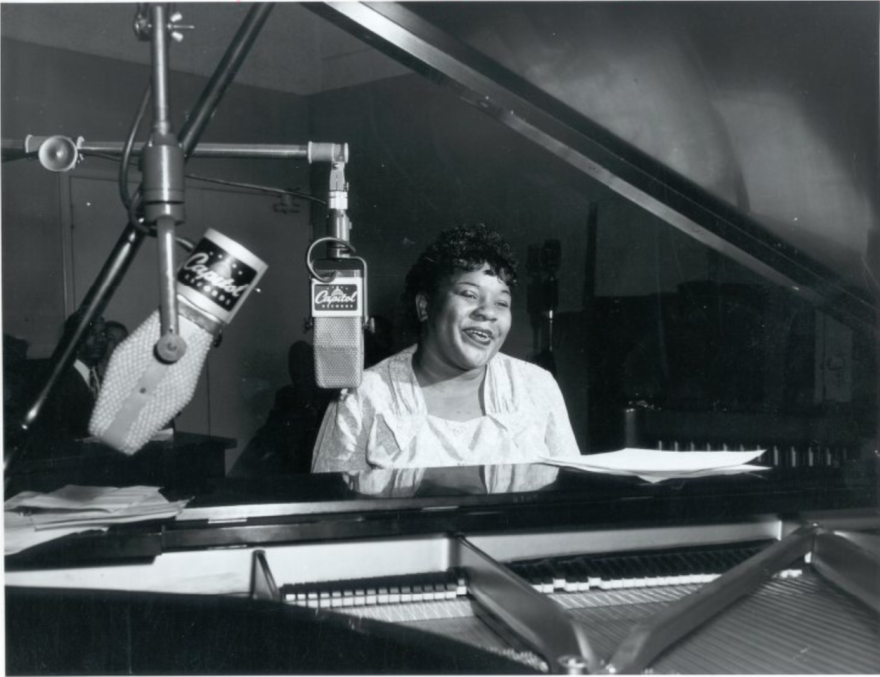This story was first published in KCUR's Creative Adventure newsletter. You can sign up to receive stories like this in your inbox every Tuesday.
Jazz is part of Kansas City’s DNA. But of the many historic and present day artists, how many women can you name?
Since the inception of jazz in the early 20th century, into the heyday of the Roaring '20s and through all the decades since, there have been exceptional women in jazz — performers who not only had the skill to impress but also the stamina to endure the male-dominated field, challenging inherent sexism and racism.
Carol Comer and Dianne Gregg founded the Kansas City Women’s Jazz Festival, seeking to celebrate, support and bring awareness to women in jazz. Running from 1978-1985, the festival brought national acts to town, as well as showcasing local artists and honoring Kansas City’s jazz heritage. Kansas City writer Carolyn Glenn Brewer documents the history of the festival in her book “Changing the Tune.”
Jazz historian and percussionist Nina Cherry created the Countess Database to bring awareness to past and present Kansas City jazz women. The project is named in honor of “Countess” Margaret Johnson, a pianist who played with Count Basie and Andy Kirk’s Clouds of Joy, but died at the age of 20, potential unfilled. The database focuses on instrumentalists and composers.
Here’s a selection of music-makers who’ve made both jazz and Kansas City all the better for their talents and perseverance.
Julia Lee

A People’s History of Kansas City dug into the legacy of one of the area’s famous names, singer and pianist Julia Lee, who thrilled and scandalized audiences with her hits like “King Sized Papa” and “Snatch and Grab It.” Listen to the story — and while you're at it, subscribe to KCUR's podcast A People's History of Kansas City.
Known as the “Queen of the Blues,” Lee started playing piano with her brother George’s band, rival to Bennie Moten’s during the 20s. At times, she split piano duties with Count Basie. The George E. Lee Singing Novelty Orchestra was first recorded by Kansas City’s first Black-owned record label, Meritt Records.
Lee started a solo career in the 30s under Capitol Records, making her a national sensation.
Lee lived most of her life in Kansas City, but proved popular the world over. In 1995, a German label released a boxed set of every known Julia Lee recording, called “Kansas City Star," that included over 100 tracks. At the American Jazz Museum, she and her brother are honored with a special “George and Julia Lee” table in the Blue Room.
Lee died in 1958, the last of the great blues singers.
Mary Lou Williams

Though born in Atlanta, Georgia, and raised in Pittsburgh, Pennsylvania, when Mary Lou Williams arrived in Kansas City, she absorbed and transformed that essential swing style, taking it for the rest of her life as she traveled the world.
Williams came back to Kansas City in 1978 as a headliner with the nascent Kansas City Women’s Jazz Festival, when her "Mass" was performed (later in life, Williams became deeply religious and converted to Catholicism). Choreography on “Mary Lou’s Mass” became part of the repertoire for the Alvin Ailey American Dance Theater.
“I’ve lived through four eras of jazz and I’ve played the styles of all of them. The greatest era of them all was Kansas City in the '30s,” Williams said at the time. She was one of the inaugural inductees in the American Jazz Museum’s Jazz Walk of Fame in 2014.
The Kansas City Jazz Orchestra performed a tribute to Williams in 2018, with big band arrangements of her Zodiac Suite, each sign linked to a jazz luminary.
Williams evolved throughout her career, incorporating musical styles from blues and ragtime to the atonal avant garde works of Igor Stravinsky and Krysztof Penderecki. An example of her creative, complex style can be heard in the track “A Fungus A Mungus,” recorded on the album “Black Christ of the Andes.”
In her honor, Mary Lou Williams Lane runs between the Paseo and Woodlawn Avenue, along 10th Street in Kansas City, Missouri.
Myra Taylor

Born in Bonner Springs, Kansas, but raised in the 18th and Vine district, Myra Taylor started performing when she was a teenager. Though she traveled the world, she spent her golden years back in Kansas City.
She started out as a dancer, but made her career as a singer. Compared to Ella Fitzgerald, she learned to forge her own path and carried the Kansas City style all over the world, with hits like “Dig It” featuring Harlan Leonard’s Rockets (remixed here by French artist Minimatic) and “Spider and the Fly” — though she was often cheated out of royalties.
She was an entertainer to her core, touring North America, Europe and Asia and settling in Frankfurt, Germany, where she owned a club during the 1970s. Her adventure-filled life inspired the musical “All For A Song.”
Soon after moving back to Kansas City in 1994, she founded a jazz quartet — the Wild Women of Kansas City — with Geneva Price, Millie Edwards and Lori Tucker. The group was featured on NPR’s “Day to Day” program in 2007.
Taylor died in 2011, performing her last show at the age of 94 — the culmination of an 80 year career. Down at 18th and Vine, where it all started, she’s honored with an archway and historic marker at the corner of the old Attucks School and a medallion on the American Jazz Museum’s Jazz Walk of Fame.
The Wild Women still perform from time to time, most recently at Unity Temple on the Plaza for the Temple Lifetime Achievement Awards, where Geneva Price was one of the 2022 honorees, but the quartet is now a trio.
Myra, they deemed, was irreplaceable.
Melba Liston

Born in Kansas City, Missouri, Melba Liston was drawn to the trombone early in life and started playing at only seven years old. Her family moved out to Los Angeles when she was young and that’s where she got her start in show business.
Eventually, the roster of bandleaders she played with included Count Basie, Dizzy Gillespie, Art Blakey, Charles Mingus, Quincy Jones, Dizzy Gillespie, Randy Weston and a host of others.
Her only album as a leader, “Melba Liston and Her ‘Bones,” epitomizes her rich, swinging and soulful style.
She was equally well known as a composer and arranger, and worked (credited and uncredited) in jazz, R&B and Motown. Liston influenced the sound of the 40s, 50s, 60 and 70s more than many people realize. She was also the arranger for Mary Lou Williams’ “Black Christ of the Andes.”
Often discouraged by the vagaries of the industry, she moved to Jamaica in 1974, where she taught at the Institute of Music. But she was convinced to come out of retirement for the 1979 Women’s Jazz Festival in Kansas City to headline an “All-Stars” band.
“Kansas City changed my life,” she told journalist Linda Dahl, who wrote “Stormy Weather: the Music and Lives of a Century of Jazzwomen,” published in 1984.
Liston was named an NEA Jazz Master in 1987 and is also an inductee into the AJM Jazz Walk of Fame.
Bettye Miller

Glamorous Bettye Miller was known as the “Queen of Kansas City jazz” (after Mary Lou Williams, of course). She studied voice in college, earning a master’s degree and continuing her studies in Philadelphia.
The pianist and singer started performing in Kansas City in 1953, where she met bassist Milt Abel. Together they formed a duo act, later married, and became staples of the jazz scene with a strong local following and acclaimed performances out of town and at festivals.
Miller’s portrait hangs in the UMKC Music/Media Library, which houses the Bettye Miller-Milt Abel Collection in the LaBudde Special Collections. The same image is used on the cover of her album, “A Portrait of Bettye,” a treasure from 1968.
She died of cancer in 1977 at only 49 years old. Abel survived her by 29 years, a list of awards and achievements attached to his career.
Miller’s daughter, Bettye Jo “BJ” Miller, is also a musician, and was in bands in Kansas City throughout the seventies and eighties. She could play keys with one hand and valve trombone with the other.
Listen to this live performance of Neckbone & Candied Yams, where BJ lays it down on trombone during “Kansas City (Here I Come).” She continues to perform, though she no longer lives in Kansas City.
Continuing tradition

Though jazz is far from equitable, more women than ever have the opportunity to follow in the footsteps of these groundbreaking artists. Marilyn Maye is 94 and still selling out shows. Deborah Brown was born in Kansas City, though she splits her time between here and Europe.
Grammy Award-nominee Oleta Adams makes her home in Kansas City, Kansas. Lisa Henry, a regular at the Blue Room, has taken Kansas City jazz to far-off places including India, Africa and Madagascar. Born in Kansas, Grammy Award-nominee Karrin Allyson launched her career in Kansas City.
Angela Hagenbach has worked as a singer and band leader for decades. A native of Weston, Missouri, she’s also turned into a historian as one of the charter members of the Black Ancestors Awareness Campaign (BAAC) of Weston. Hagenbach's hometown hosts its second-annual Juneteenth Heritage Jubilee on Saturday, June 18, which will include music, poetry and storytelling, honoring the legacy of Weston’s African American community.
Singer/actor Eboni Fondren is, in a way, the face of Kansas City jazz for out-of-towners, featured on Visit KC’s 2022 Official Guide. Fondren performs with the Kansas City Jazz Orchestra for the Kansas City PBS series KC Performs. Her group Eboni & The Ivories was voted Best Jazz Band in Kansas City by The Pitch’s reader poll.
The tradition and legacy of jazz is alive, generation to generation.
Want more adventures like this? Sign up for KCUR's Creative Adventure Email.







